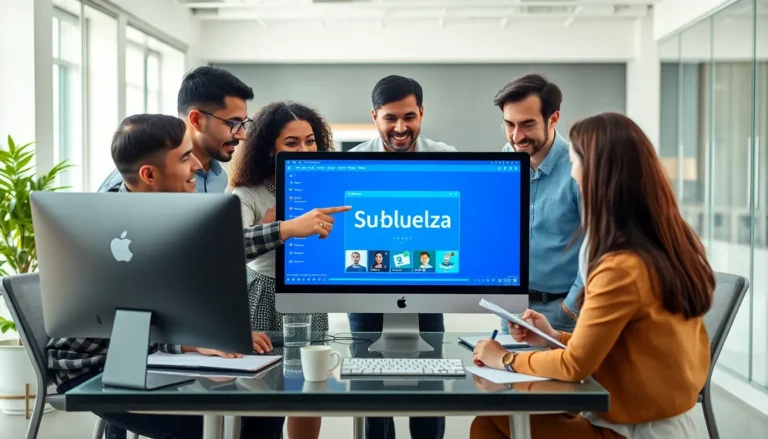In a world where virtual meetings have become the norm, capturing those moments can be just as important as attending them. Whether it’s a brilliant idea shared during a brainstorming session or that hilarious blooper when someone forgets to mute, knowing how to record on Zoom on an iPhone can save the day. Imagine having a digital time capsule of all your best (and worst) moments at your fingertips.
Table of Contents
ToggleHow To Record On Zoom On iPhone
Recording on Zoom using an iPhone involves straightforward steps. First, ensure that the Zoom app is installed and updated to the latest version. Navigate to the app’s settings, then select “Meeting.” Toggle the “Cloud Recording” setting on to enable recording.
Join a meeting as a host or co-host. Only hosts and co-hosts can initiate recordings. Tap the “More” button at the bottom right corner of the screen during the meeting. From the options presented, choose “Record” to start capturing video and audio.
For recording locally on an iPhone, ensure that the “Local Recording” feature is enabled in the settings. Tap on the “More” button again, then select “Record to the Cloud” or “Record Locally,” depending on preference. Stopping the recording is as simple as tapping “More” and then selecting “Stop Recording.”
After stopping, the recording automatically saves to your device or cloud account. Access recorded meetings in the “Meetings” tab of the Zoom app. For cloud recordings, log in to your Zoom account via a web browser to view or download.
Keep in mind that storage availability affects local recording capabilities. Regularly check storage space to ensure the iPhone can save new recordings. Familiarity with these steps enhances the overall Zoom experience, making it easier to capture important meetings or memorable moments.
Checking Prerequisites
Confirming prerequisites ensures a smooth Zoom recording experience. Users must check their account and device compatibility.
Zoom Account Requirements
Zoom accounts must have the correct settings enabled for recording. Users who want to record need either a Pro, Business, or Education account to access cloud recording. Free accounts only allow local recordings but still require specific configurations. Additionally, users must sign in to their Zoom account before attempting to record. Finally, ensuring the account settings reflect the recording preferences will help streamline the recording process.
iPhone Compatibility
iPhones running iOS 11 or later support the Zoom app for recording. It’s essential to download the latest version of the Zoom app to utilize its full functionality. Users must also ensure their iPhone has enough storage space for saved recordings. Checking that the device settings allow access to the microphone and camera is crucial for capturing audio and video quality. Lastly, a stable internet connection enhances the recording experience on the iPhone.
Steps To Record On Zoom
Recording on Zoom offers a practical way to capture meetings on an iPhone. Follow these steps to efficiently record your sessions.
Starting a Meeting
To start recording, initiate a Zoom meeting by tapping the app icon. Select “New Meeting” or join an existing one through the link. Once in the meeting, ensure you are the host or co-host. Hosts can start recording right away, while co-hosts might require permission. Look for the “Record” button at the bottom of the screen. Tapping this button activates the recording function.
Enabling Recording Option
Before recording, enable the recording option in Zoom settings. Open the Zoom app and navigate to “Settings,” then select “Meetings.” Find the “Cloud Recording” option and switch it on if you have a Pro, Business, or Education account. This feature allows for cloud storage of recordings. Free accounts are limited to local recordings, so users should be aware of their account type. Adjusting this setting ensures users can access their recordings later without storage constraints.
Using Built-In Features
Utilize Zoom’s built-in features for effective recording. Tap the “Record” button during the meeting to start capturing audio and video. Users can also pause or stop the recording as needed. After concluding the meeting, the app automatically processes the recording. Check the “My Recordings” section in the Zoom app to locate saved meetings. This area provides easy access to revisit important discussions later.
Tips For Effective Recording
Effective recording on Zoom enhances the clarity and quality of virtual meetings. Following specific tips ensures better outcomes from recordings.
Optimal Settings
Set video resolution to high for clearer visuals. Adjust the recording quality settings within Zoom’s preferences based on storage capacity. Use the cloud recording option for seamless access across devices. Enable screensharing to capture essential presentations or documents. Check the recording path in settings to ensure space availability.
Ensuring Good Audio Quality
Utilize a high-quality microphone for crisp, clear sound. Choose a quiet location to minimize background noise during recording. Enable noise suppression in Zoom settings to filter out unwanted sounds. Test audio levels before starting the meeting to confirm clarity. Encourage all participants to use earphones to prevent echo or feedback during discussions.
Common Issues And Troubleshooting
Recording on Zoom using an iPhone can present several challenges. Users often encounter issues with storage space. Ensure sufficient storage is available for recordings, especially if local recording is being utilized. If the storage space is limited, consider deleting unnecessary files or moving recordings to a cloud service.
Compatibility of the iOS version may cause problems. iPhones must run iOS 11 or later to support the latest Zoom features. If an older iOS version is installed, it’s important to update the device through the Settings app.
Permissions for microphone and camera access may impact recording capabilities. Users must enable these permissions within their iPhone settings. If permission requests are ignored, Zoom may not allow recording.
Network connectivity issues can interrupt recordings. A stable Wi-Fi connection is essential for seamless participation and recording. Users can troubleshoot connectivity by restarting the router or moving closer to the Wi-Fi source.
Inconsistent audio quality often frustrates users. Employing a high-quality microphone can significantly improve sound clarity. If echo or feedback persists, using earphones during meetings is an effective solution. Participants should also test audio levels prior to starting a meeting.
Cloud recording permissions can be limited by account type. Ensure the Zoom account is a Pro, Business, or Education level for accessing cloud features. Local recording is available for free accounts but may come with restrictions. Users must check their account settings to confirm which recording options are accessible.
Lastly, users may struggle to access saved recordings. In the Zoom app, navigating to the “My Recordings” section provides easy access to recorded content. If recordings are missing, checking both the app and the designated storage location can help resolve this issue.
Recording on Zoom with an iPhone opens up a world of possibilities for users looking to capture important meetings and memorable moments. By following the outlined steps and ensuring the right settings are in place, anyone can create high-quality recordings that serve as valuable resources.
Whether it’s for professional use or personal memories, understanding how to effectively record can greatly enhance the virtual meeting experience. With the right tools and tips, users can navigate potential challenges and enjoy seamless access to their recordings. Embracing this technology not only preserves moments but also enriches communication and collaboration in today’s digital landscape.


